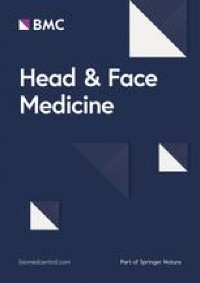|
Medicine by Alexandros G. Sfakianakis,Anapafseos 5 Agios Nikolaos 72100 Crete Greece,00302841026182,00306932607174,alsfakia@gmail.com,
Αρχειοθήκη ιστολογίου
-
►
2023
(272)
- ► Φεβρουαρίου (141)
- ► Ιανουαρίου (131)
-
►
2022
(2066)
- ► Δεκεμβρίου (80)
- ► Σεπτεμβρίου (170)
- ► Φεβρουαρίου (190)
- ► Ιανουαρίου (203)
-
▼
2021
(7399)
- ► Δεκεμβρίου (186)
- ► Σεπτεμβρίου (472)
-
▼
Φεβρουαρίου
(851)
-
▼
Φεβ 07
(50)
- Extended Scalp Flaps for Extensive Soft Tissue Sca...
- Skull Base Anatomy in Patients with Bilateral Choa...
- Antibiotic Use in Lateral Skull Base Surgery: A Su...
- Functional Outcomes and Postoperative Cerebral Ven...
- Transoral Endoscopic Localization of the Paraphary...
- Long-term management of lenvatinib-treated thyroid...
- The content management system ILIAS
- Image‐guided robots for low dose rate (LDR) prosta...
- COVID-19 associated anxiety enhances tinnitus
- Validation of the Nasal Obstruction Symptom Evalua...
- Relationship between back posture and early orthod...
- Diagnostic Value of Butanol Threshold Test in COVI...
- Tracheoesophageal puncture closure with annular mu...
- A phase II study of nimotuzumab (TheraCim‐hR3) con...
- Characterizing postoperative physiologic swallow f...
- Surgeon‐performed ultrasound with fine‐needle aspi...
- Mucopyocele: An Entity Infrequently Reported as a ...
- Role of Blood Investigations in Idiopathic Unilate...
- Association of medicaid expansion of the Affordabl...
- Thyroid disease: Long-term management of hyperthyr...
- Role of HRCT Temporal Bone in Predicting Surgical ...
- Endoscopic Endonasal Approaches to the Clival Region.
- Predictors of a Normal Sleep Study in Healthy Chil...
- COVID-19 infection rate among tertiary referral ce...
- Diced costal cartilage graft combined with muscle ...
- Modified intraoperative distal compression method ...
- Setting up a new microsurgical breast service in a...
- Phonetic discrimination mediates the relationship ...
- Redirecting drug repositioning to discover innovat...
- Compartmentalised metabolic programmes in human an...
- Feasibility of Personal Sound Amplification Produc...
- Predictive value of olfactory and taste symptoms i...
- Effect of obstructive sleep apnea on immunity in c...
- Type 2 diabetes mellitus increases peritonsillar a...
- Sialendoscopy combined with transoral sialodochopl...
- Feasibility of Surgical Treatment for Laryngomalac...
- Chirurgie thyroïdienne avec hypnosédation : à prop...
- Planification virtuelle comparée à la conformation...
- Plasma Ablation assisted Endoscopic Endonasal Tran...
- Surgical approach to the facial recess influences ...
- Benign recurrent vestibulopathy: MRI and vestibula...
- The use of periocular fillers in aesthetic medicine.
- A sling of a normal right inferior vena cava aroun...
- [New approval: Atezolizumab and bevacizumab for fi...
- [Drug approval: Olaparib - metastatic castration-r...
- Radioactive iodine-125 seed localization as an aid...
- Zinc-based triazole metal complexes for efficient ...
- Free Flap Reconstruction in a Tongue Cancer Patien...
- Acupoint-brain (acubrain) mapping: Common and dist...
- Cranial aseptic osteomyelitis associated with pyod...
-
▼
Φεβ 07
(50)
-
►
2020
(2517)
- ► Δεκεμβρίου (792)
- ► Σεπτεμβρίου (21)
- ► Φεβρουαρίου (28)
-
►
2019
(12076)
- ► Δεκεμβρίου (19)
- ► Σεπτεμβρίου (54)
- ► Φεβρουαρίου (4765)
- ► Ιανουαρίου (5155)
-
►
2018
(3144)
- ► Δεκεμβρίου (3144)
Ετικέτες
Πληροφορίες
Κυριακή 7 Φεβρουαρίου 2021
Extended Scalp Flaps for Extensive Soft Tissue Scalp Defects as a Day Surgery Procedure Under Local Anesthetic: A Single Centre Experience
Skull Base Anatomy in Patients with Bilateral Choanal Atresia: A Radiographic Study
|
Antibiotic Use in Lateral Skull Base Surgery: A Survey of the North American Skull Base Society
|
Functional Outcomes and Postoperative Cerebral Venous Sinus Thrombosis after Translabyrinthine Approach for Vestibular Schwannoma Resection: A Radiographic Demonstration of Anatomic Predictors
|
Transoral Endoscopic Localization of the Parapharyngeal Internal Carotid Artery
|
Long-term management of lenvatinib-treated thyroid cancer patients: a real-life experience at a single institution.
|
The content management system ILIAS
|
Image‐guided robots for low dose rate (LDR) prostate brachytherapy: perspectives on safety in design and use
|
COVID-19 associated anxiety enhances tinnitus
|
Validation of the Nasal Obstruction Symptom Evaluation Scale in Pediatric Patients
|
Relationship between back posture and early orthodontic treatment in children
|
Αναζήτηση αυτού του ιστολογίου
! # Ola via Alexandros G.Sfakianakis on Inoreader
-
Does CBD Oil Lower Blood Pressure? This article was originally published at SundayScaries." Madeline Taylor POSTED ON January 13, 20...
-
Abstract Purpose Clinicians must balance the risks from hypotension with the potential adverse effects of vasopressors. Experts have rec...







